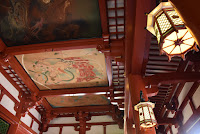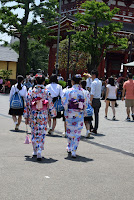(...)
Once more under the guidance of Mr. Hiroshi we travelled for the first time on the Tokyo subway, whose network looked quite intricate, though I was not particularly concerned as I just had to follow my guide as we headed towards the Asakusa district. Once we were out we tried some fresh fruit juices which were being sold at one of the subway exits.




We took a lift up at the Asakusa station to get an aerial perspective of the Nakamise-dori alley pertaining to the Senjo-ji Temple complex, which was quite impressive because we could clearly see the amount of people.


Popularly known as the Asakusa Kannon Senjo-ji Temple is Tokyo's most sacred temple. According to the legend in 628 AD two fishermen are said to have dragged a small golden statue of Kannon, the Budhist goddess of mercy from the Sumida river. Their master is said to have then built her a temple by 645, which soon grew in fame and size.
We stopped at the Kaminarimon (Thunder) gate with their guardian statues briefly before getting the courage to enter the Nakamise-dori alley sided by thousands of small stalls with traditional wares. We found it difficult to stop and buy anything at the stalls given thedifferent interests we had and the limited amount of time, until we stopped at a traditional cake making stall suggested by Mr. Hirochi.






To our left the five storey pagoda, though being a replica of its original, caught one's attention and so did the Hozo-mon gate, where we stopped to have our Omikuji numbered sticks' fortune"reading". Mr. Hiroshi and I because of the not so good readings had to fold the pieces of paper where our "fate" had been dictated and attach them with a strong knot to a metal wire.









The incense burner is one of the Temple's focal points because of the belief that it keeps people, who waft the smoke over them or their body parts, healthy. We soon prepared ourselves in the ritualistic way to walk into the Temple itself

The main Hall houses the original Kannon image where worshippers come to pay their respects by throwing coins and lighting candles. Several paintings could be seen on its ceiling. Said to be a 20th century work by Insho Domoto didn't surprise me, once the Temple is said not to have survived the II World War and has therefore been restored following the initial Ledo-era layout.




We then headed towards the right side where we came across the Asakusa Jinja dedicated to the fishermen who found the statue, a number of staues donated by a wealthy Edo merchant, as well as the Niten-mon Gate, which dates back to 1618 and used to be the entrance to the original shrine.






(To be continued)






































No comments:
Post a Comment